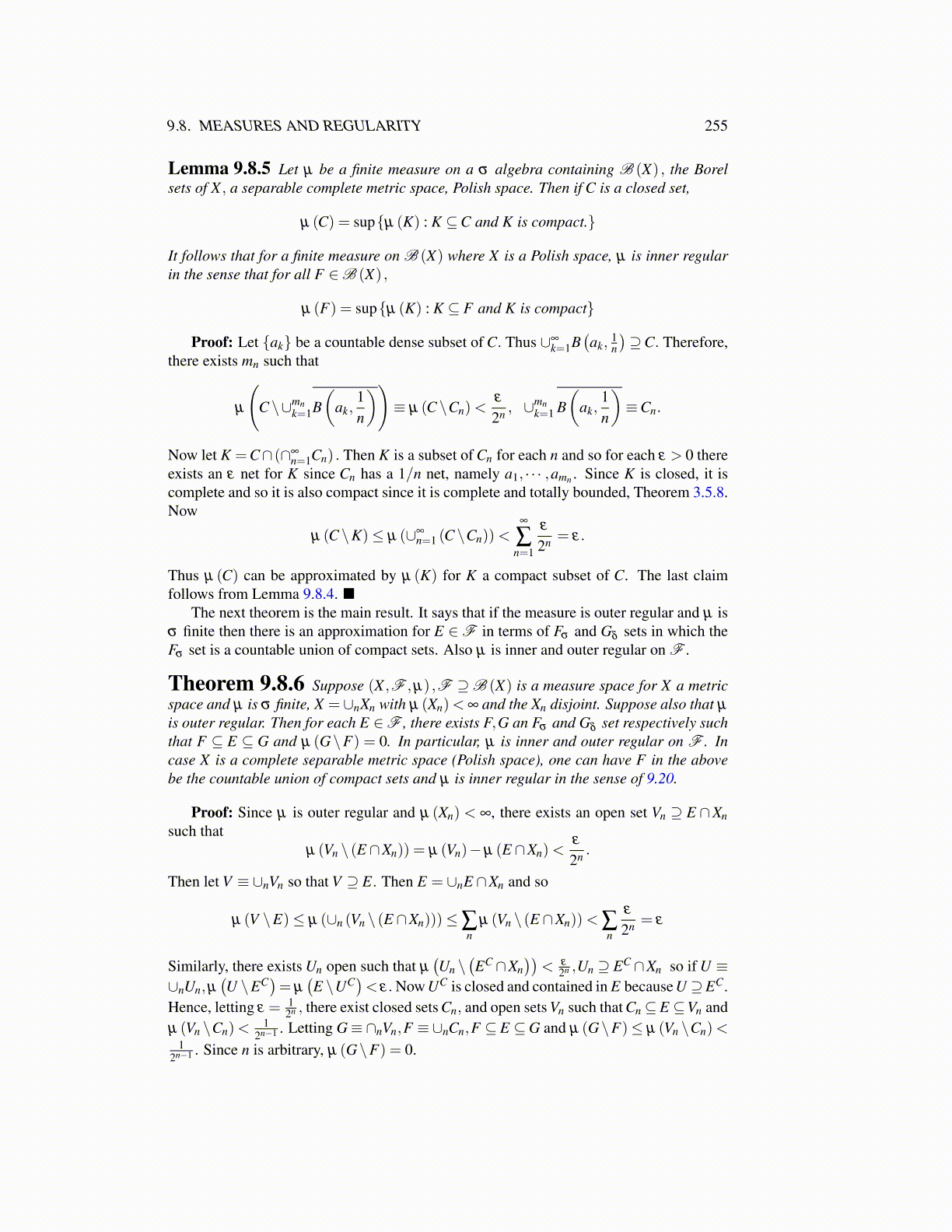
9.8. MEASURES AND REGULARITY 255
Lemma 9.8.5 Let µ be a finite measure on a σ algebra containing B (X) , the Borelsets of X , a separable complete metric space, Polish space. Then if C is a closed set,
µ (C) = sup{µ (K) : K ⊆C and K is compact.}
It follows that for a finite measure on B (X) where X is a Polish space, µ is inner regularin the sense that for all F ∈B (X) ,
µ (F) = sup{µ (K) : K ⊆ F and K is compact}
Proof: Let {ak} be a countable dense subset of C. Thus ∪∞k=1B
(ak,
1n
)⊇C. Therefore,
there exists mn such that
µ
(C \∪mn
k=1B(
ak,1n
))≡ µ (C \Cn)<
ε
2n , ∪mnk=1 B
(ak,
1n
)≡Cn.
Now let K =C∩ (∩∞n=1Cn) . Then K is a subset of Cn for each n and so for each ε > 0 there
exists an ε net for K since Cn has a 1/n net, namely a1, · · · ,amn . Since K is closed, it iscomplete and so it is also compact since it is complete and totally bounded, Theorem 3.5.8.Now
µ (C \K)≤ µ (∪∞n=1 (C \Cn))<
∞
∑n=1
ε
2n = ε.
Thus µ (C) can be approximated by µ (K) for K a compact subset of C. The last claimfollows from Lemma 9.8.4. ■
The next theorem is the main result. It says that if the measure is outer regular and µ isσ finite then there is an approximation for E ∈F in terms of Fσ and Gδ sets in which theFσ set is a countable union of compact sets. Also µ is inner and outer regular on F .
Theorem 9.8.6 Suppose (X ,F ,µ) ,F ⊇B (X) is a measure space for X a metricspace and µ is σ finite, X =∪nXn with µ (Xn)< ∞ and the Xn disjoint. Suppose also that µ
is outer regular. Then for each E ∈F , there exists F,G an Fσ and Gδ set respectively suchthat F ⊆ E ⊆ G and µ (G\F) = 0. In particular, µ is inner and outer regular on F . Incase X is a complete separable metric space (Polish space), one can have F in the abovebe the countable union of compact sets and µ is inner regular in the sense of 9.20.
Proof: Since µ is outer regular and µ (Xn) < ∞, there exists an open set Vn ⊇ E ∩Xnsuch that
µ (Vn \ (E ∩Xn)) = µ (Vn)−µ (E ∩Xn)<ε
2n .
Then let V ≡ ∪nVn so that V ⊇ E. Then E = ∪nE ∩Xn and so
µ (V \E)≤ µ (∪n (Vn \ (E ∩Xn)))≤∑n
µ (Vn \ (E ∩Xn))< ∑n
ε
2n = ε
Similarly, there exists Un open such that µ(Un \
(EC ∩Xn
))< ε
2n ,Un ⊇ EC ∩Xn so if U ≡∪nUn,µ
(U \EC
)= µ
(E \UC
)< ε. Now UC is closed and contained in E because U ⊇EC.
Hence, letting ε = 12n , there exist closed sets Cn, and open sets Vn such that Cn ⊆E ⊆Vn and
µ (Vn \Cn)<1
2n−1 . Letting G≡∩nVn,F ≡∪nCn,F ⊆ E ⊆G and µ (G\F)≤ µ (Vn \Cn)<1
2n−1 . Since n is arbitrary, µ (G\F) = 0.